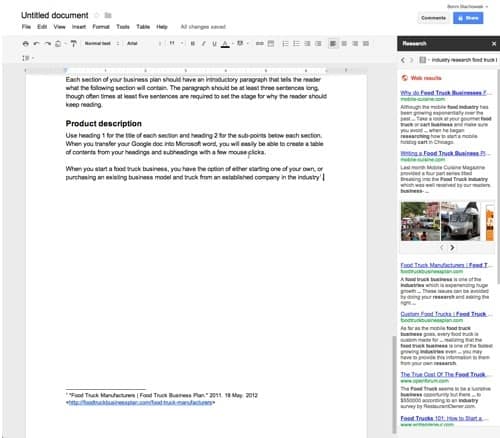Google has released a new research tool to help students capture and cite information, images, and quotes related to a particular reseach problem. The tool is available on the right-hand side of your window when composing a document on Google Docs.
Below is a screenshot of some research I plan on having my Introduction to Business students do in the Fall on launching a food truck business. Note that the citation is made as a footnote at the bottom of the page and only requires two clicks to create.
I see the following advantages and disadvantages to the use of Google's new research tool in my classes:
ADVANTAGES
- Integration: students can have research tightly integrated with their workflow, perhaps making them more likely to incorporate citations and sources into their early college work
- Ease of use: When I created a new Google doc to try out the service, the research bar was automatically there on the right-hand side of the window. No training needed. The only thing that may not be obvious from the start is that you need to hover your mouse over an item in the list on the right in order to access the options that are available (see screenshot below)
DISADVANTAGES
- Lack of citation specificity: As of 5/18/12, the only option for inserting a citation is as a footnote. Our school is standardized on APA as a research paper format, though the strictness of professors varies considerably within individual courses. I will need to decide if getting students accustomed to integrating research into everything they do will negate the negative of getting them to rely on footnotes for some of the earlier writing they do in their degree program. Though it would be just a few more steps to enter the sources into a robust citing tool, such as Zotero, I may lose some of the students along the way.
- Reliance on Google Docs for document composition: As a business professor, I have always required students to compose in Microsoft Word (or at least do a save-as MS Word before submitting their work). Since Microsoft's marketshare has held at over 90% of their Office Suite for years now, it seems prudent to have students learning to use that tool to prepare them for entering the workforce. However, since the capabilities of Google docs have increased so much in year's past, it is starting to seem like students would be well positioned to work with any Word Processor made available to them in the future, if they excelled at Google Doc's word processing features.
As I explored Google's new research tool, I discovered that Google Docs' features have significantly increased in the recent past. While composing text, students have access to pre-formatted headings and subheadings, as well as the ability to create a table of contents with a few clicks of their mouse. Considering the collaborative nature of Google Docs and the group business plan project I assign to students for my introductory business class, the benefits may just outweight any negatives I've expressed above.
More information and a review of Google's new research tool is available from MacWorld.
Let us know in the comments what you think about the new Google Docs research tool. Do you see making use of this with your students? Do you have any ideas about how you might overcome the limitation of only being able to cite with footnotes? How important do you think it is for students to be learning on what still seems to be the industry standard word processor today, Microsoft Word?





Interesting new service! Yeah, that’s a bummer that you need to use Google docs and that it doesn’t work with APA. I think I’m going to stick with Zotero for now, but great to know this is out there.